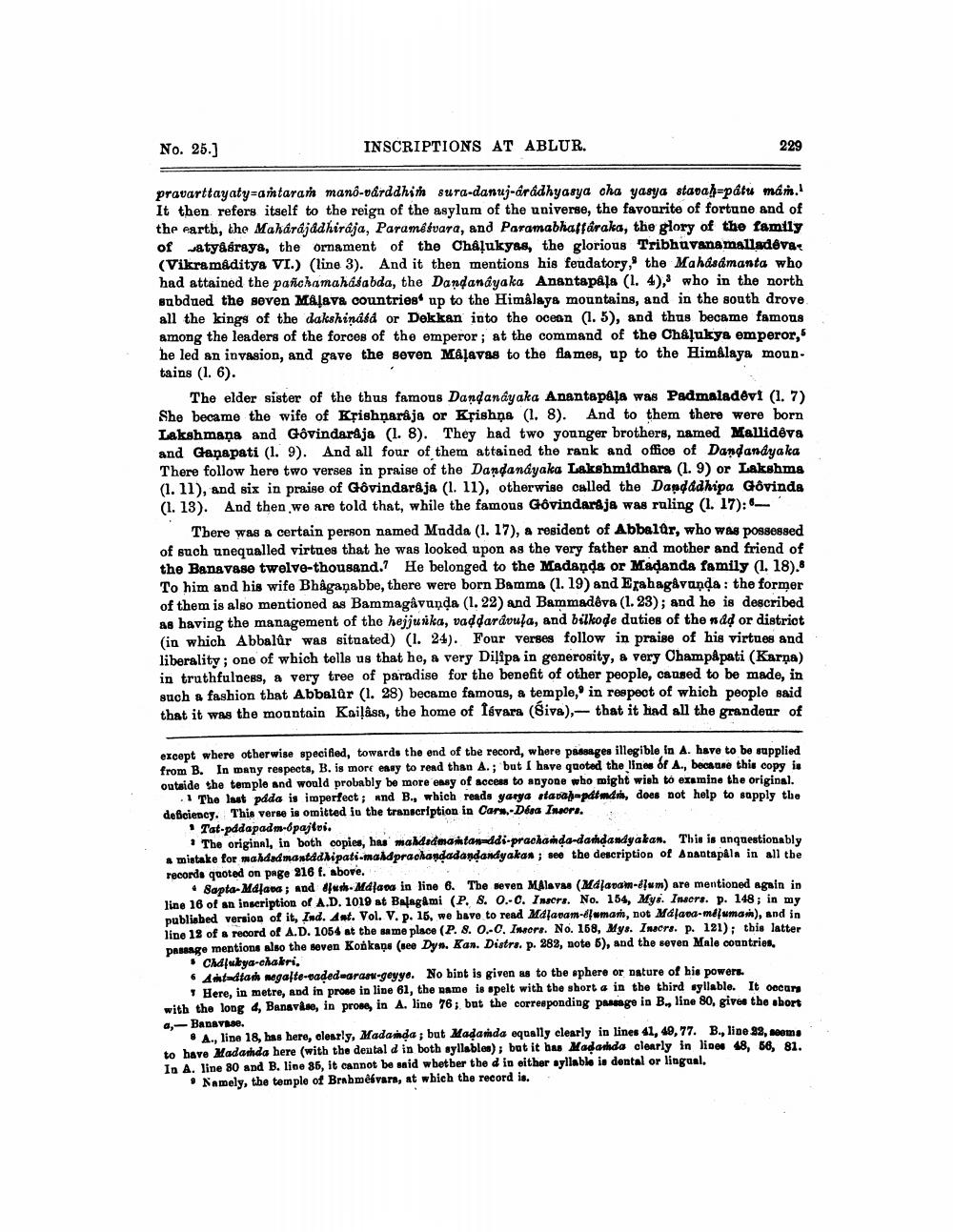________________
No. 25.)
INSCRIPTIONS AT ABLUR.
229
pravarttayaty-antaran mano-värddhith sura-danuj-árádhyasya cha yasya starah-patu man. It then refers itself to the reign of the asylum of the universe, the favourite of fortune and of the earth, the Maharajadhiraja, Paramêsvara, and Paramabhaffäraka, the glory of the family of waty&graya, the ornament of the Châļukyas, the glorious Tribhuvanamalladêve (Vikramaditya VI.) (line 3). And it then mentions his feudatory, the Mahasamanta who had attained the pañchamahasabda, the Dandanayaka Anantapala (1. 4), who in the north subdued the seven MAJava countries up to the Himalaya mountains, and in the south drove all the kings of the dakshinasd or Dekkan into the ocean (1.5), and thus became famous among the leaders of the forces of the emperor; at the command of the Chåļukye emperor, he led an invasion, and gave the seven Mâlavas to the flames, up to the Himalaya moun. tains (1.6).
The elder sister of the thus famous Dandanayaka Anantapaļa was Padmaladevi (1.7) She became the wife of Krishnaraja or Kfishņs (1. 8). And to them there were born Lakshmana and Govindaraja (1. 8). They had two younger brothers, named Mallideva and Ganapati (1. 9). And all four of them attained the rank and office of Dandandyaka There follow here two verses in praise of the Dandanayaka Lakshmidhars (1.9) or Lakshma (1. 11), and six in praise of Govindaraja (1. 11), otherwise called the Dandadhipa Govinda (1. 13). And then we are told that, while the famous Gôvindarsja was ruling (1. 17): 6
There was a certain person named Madda (1. 17), a resident of Abbalor, who was possessed of such unequalled virtues that he was looked upon as the very father and mother and friend of the Banavase twelve-thousand. He belonged to the Madaņda or Madanda family (1. 18). To him and his wife Bhaganabbe, there were born Bamma (1. 19) and Erahagavanda : the former of them is also mentioned as Bammagåvanda (1. 22) and Bammadêva (1.23); and he is described as having the management of the hejjurika, vaddarávula, and bilkode duties of the add or district (in which Abbalûr was situated) (1. 24). Four verses follow in praise of his virtues and liberality; one of which tells us that he, a very Dilipa in generosity, & very Champápati (Karna) in truthfulness, a very tree of paradise for the benefit of other people, caused to be made, in such a fashion that Abbalûr (1. 28) became famous, a temple, in respect of which people said that it was the mountain Kaiļåsa, the home of Isvara (Siva), - that it had all the grandeur of
except where otherwise specified, towards the end of the record, where passages illegible in A. have to be supplied from B. In many respects, B. is more easy to read than A.; but I have quoted the lines of A., because this copy is outside the temple and would probably be more easy of access to anyone who might wish to examine the original.
. 1 The last pada is imperfect; and B., which reads yarya raval-pát mdus, does not help to supply the deficiency. This verse is omitted in the transcription in Cars. Désa Incore.
• Tat.pddapad-pajtoi.
• The original, in both copies, has maldadmantanaddi-prachanda-dardandyakan. This is anquestionably mintake for mahdadmantadipati-malprachandadandandyakan; see the description of Anantapkla in all the recorda quoted on page 216 f. above,
• Sapta-Mdjans; and fuss-Melava in line 6. The seven MAlava (Málaram-éļum) are mentioned again in line 16 of an inscription of A.D. 1019 at Balagmi (P, 8. 0.-0. Insera. No. 154, Mys. Ineers. p. 148; in my publiebed version of it, Ind. Ant. Vol. V. p. 16, we have to read Mdlanam-dumanis, not Mdland-duman), and in line 18 of a record of A.D. 1054 at the same place (P. 8. 0.-0. Insors. No. 158, Mys. Inaors. p. 121); this latter Pasange mentions also the seven Konkane (nee Dyn. Kan. Distrs. p. 282, note b), and the soven Male countries,
Chafulya-chakri. 6 Amtadtad megafte-padedearan-goyye. No bint is given as to the sphere or nature of his powers.
Here, in metre, and in prose in line 61, the game is spelt with the short a in the third syllable. It oocan with the long 4, Banavise, in prome, in A. line 76; but the corresponding passage in B., line 80, give the abort 0,- Bansvase.
A., line 18, has here, elesrly, Mada da; but Madamda equally clearly in lines 41, 49, 77. B., line 32, soms to have Madamda here (with the dental d in both syllables); but it has Madarda clearly in line 18, 56, 81. In A. line 80 and B. line 36, it cannot be said whether the d in either ayllable is dental or lingeal,
. Namely, the temple of Brahméivara, at which the record is.




